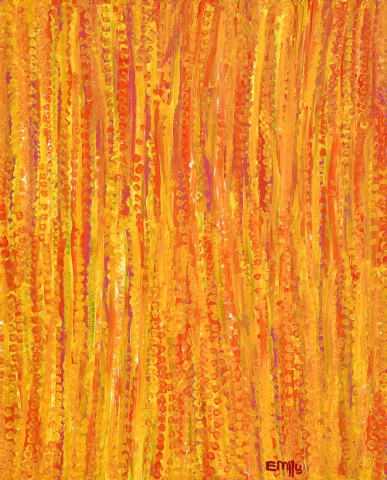CEREMONY, 1994
EMILY KAME KNGWARREYE
synthetic polymer paint on linen
152.0 x 121.5 cm
signed lower right: Emlly [sic]
signed verso: Emlly [sic]
bears inscription verso: artist's name, size and Delmore Gallery cat. 94H054
Commissioned by Delmore Gallery, via Alice Springs, Northern Territory
William Mora Galleries, Melbourne
Applied Chemicals Collection, Melbourne
Deutscher and Hackett, Melbourne, 29 November 2007, lot 35
Private Collection, Sydney
Of My Country: Emily Kame Kngwarreye, The Applied Chemicals Collection, Bendigo Art Gallery, Victoria, 1 May – 30 May 1999; Hamilton Art Gallery, Victoria, 4 June – 10 July 1999; Swan Hill Regional Gallery, Victoria, 16 July – 22 August 1999; Wagga Wagga Gallery, New South Wales, 27 August – 19 September 1999; Mornington Peninsula Regional Gallery, Victoria, 28 December 1999 – 2 February 2000; George Adams Gallery, Victorian Arts Centre, Victoria, 31 March – 30 April 2000 (illus. in exhibition catalogue)
This work is accompanied by a certificate of authenticity from Delmore Gallery, via Alice Springs which states: ‘On this canvas, the artist’s choice of a rich yellow represents the most important plant in her custodianship, namely the “Anooralya”, a hardy and fertile plant that provides both a tuber vegetable and a seed-bearing flower called “kame” – Emily’s tribal name. Other colours reflect the time of the season when particular bush flowers flourish. These flowers contain seeds that are collected to make types of seed cake, damper, medicines and love potions. Other colours symbolises the ‘ndorkwa’, or bush plum, when unripe. The dots being placed in lineal fashion and placed amongst lines, connects with the practise of anointing the body with lineal designs during ceremony, thus adding another dimension of celebration in the execution of this painting.
Ceremony reinforces through narrative, the significance of this knowledge. As well, it teaches basic social codes and obligations through her paintings, she serves to reinforce her knowledge amongst those who are to carry on after her.’
